How to Make a Chinoiserie Planter for a Handmade Topiary
For centuries, topiaries, have provided a sophisticated and whimsical decorative accessory. Have you ever made a handmade topiary? Have you used decoupage to make a pretty planter? I wanted to combine these two crafts to make a new decorative accessory for our home. This new project is about how to make a Chinoiserie planter for a handmade topiary.
One craft item sparked the idea to embark on a craft journey, turning a simple garden pot into a chic Chinoiserie topiary planter.
This handmade piece is a display of elegance, combining the vibrancy of topiaries with the classic beauty of Chinoiserie design.
The process promised not just a creative outlet but a unique addition to my home decor collection. With Mod Podge, pretty napkins, and a dash of imagination, I set out to create something special, turning everyday craft supplies into chic decor pieces.
This DIY project is not just a new addition to our home decor. It’s also my contribution to this month’s Creative Craft Blog Hop, hosted by Sara of Birdz of a Feather.
If you are joining me from Tammy at Patina and Paint, then I’m so happy you are here. Ready for more creative craft ideas?
Crafting Your Own Topiary Chinoiserie Planter
Topiaries have gained tremendous popularity in recent years. They bring a classic, organic accessory to any style of home.
We have had a pair since we built our previous home. The containers were originally a shade of black, but a few years ago, I used paint and gold leaf to transform them into this look.
I few weeks ago, I made my first topiary project for spring. For that project, I used boxwood balls to make topiaries for a spring vignette.
For this new topiary project, I would make the topiaries from scratch and create a beautiful chinoiserie-style planter using decoupage.
Gathering Your Materials
This post contains affiliate links to products used in the creation of this project. If you should order any item from this site, I may receive compensation, but you do not pay a penny more. Your purchase is greatly appreciated as it helps support the continued publication of this site.
This is another project that required a small number of craft supplies I already had on hand. I only had to purchase one item specifically for this project.
For the Chinoiserie Planters:
- terra cotta garden pots – fortunately, we had these in the garage

- matte Mod Podge – on hand. Mod podge is a must; it’s the decoupage glue that bonds the beautiful napkin layers to the pots.

- foam brushes – on hand
- cocktail or luncheon-size paper napkins – since I wanted a very Chinoiserie-looking planter, I found this beautiful blue and elegant Chinoiserie design. The intricate Chinoiserie pattern was ideal for my topiary planter. It’s the design of the napkin you choose that results in unique, one-of-a-kind items. The napkin design that complements your vision transforms a plain ceramic vase or garden pot into a vintage treasure.

For the Handmade Topiaries:
- styrofoam balls – I found these in the dresser in the garage where I keep extra DIY supplies. They are 6 inches in diameter. I don’t remember buying them, but I think they came from Dollar Tree or Hobby Lobby. They were what prompted me to start this project.
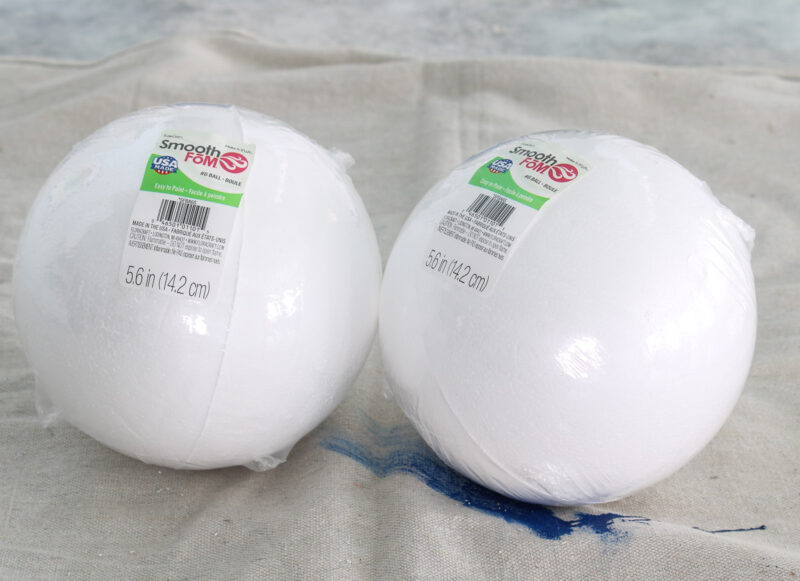
- drill – I used my drill with a large bit to make a hole for the dowel rod
- 1/4-inch wide wood dowel rod, 48 inches long – I bought two of these at Lowe’s for my spring vignette topiary project. I only used one, so I had another one on hand. I cut two 15-inch lengths for this new topiary project.
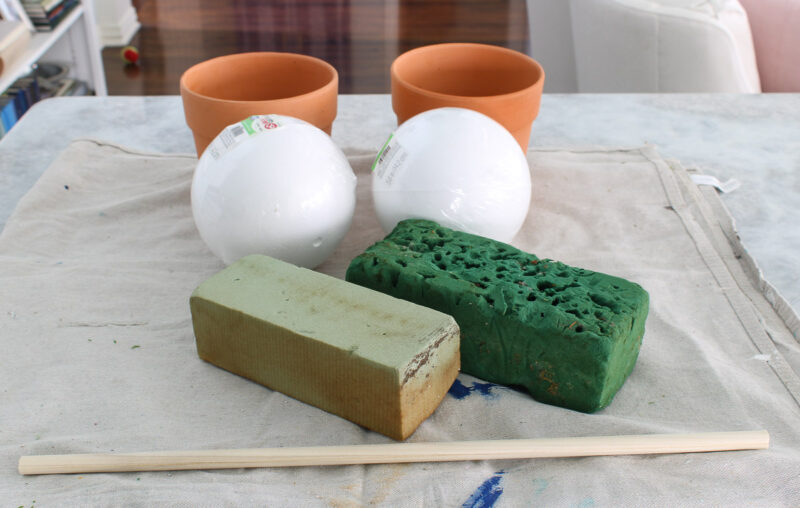
- green paint to paint the styrofoam balls – I used One Step Paint in Boxwood Green
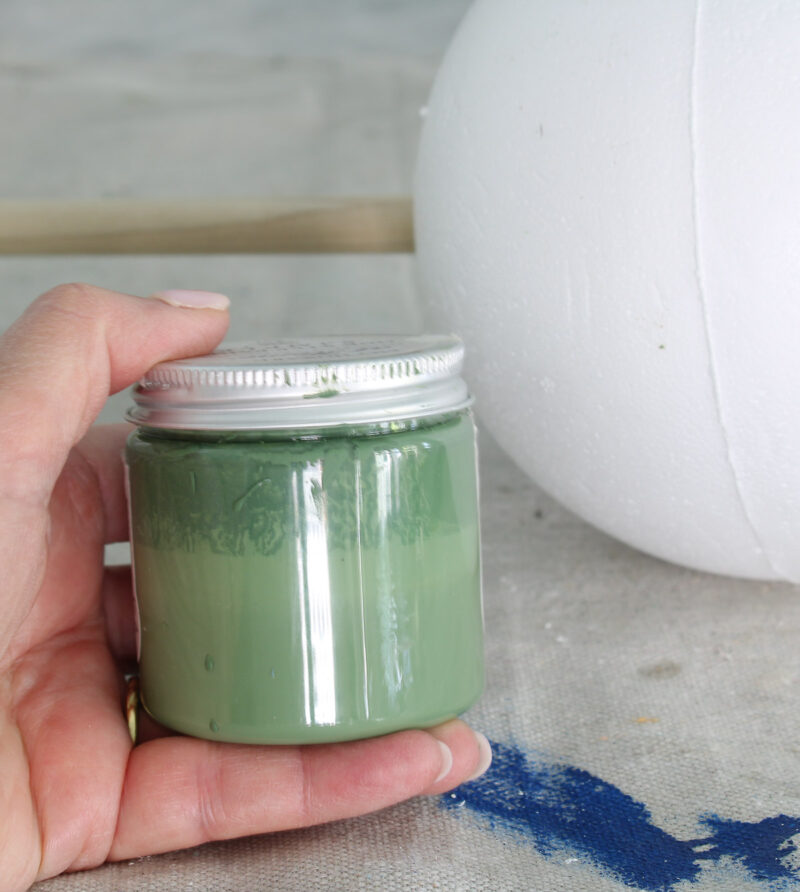
- small paintbrush
- greenery garland or individual stems – I had two garlands that I bought and used for Christmas garlands on our mantel.
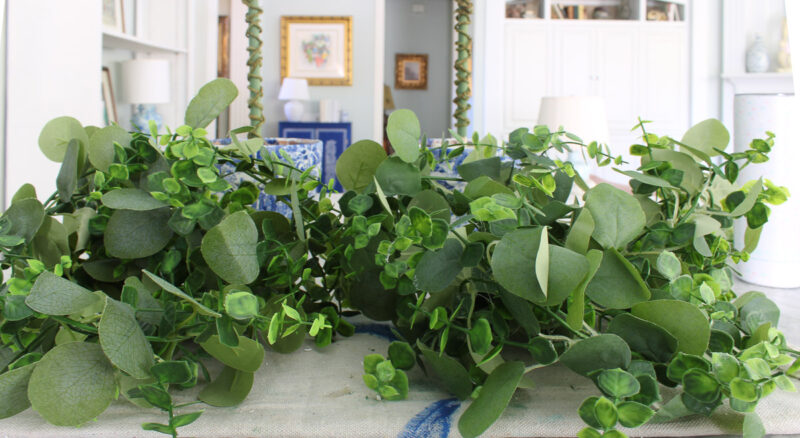
- glue gun and glue sticks
- florist foam or styrofoam to secure dowel rod in planter
- moss to cover the base florist foam
Preparing the Planter
First, gather your garden pots. They must be clean, ensuring the decoupage medium adheres properly. These planters had never been used, but I still wiped them with a paper towel to remove any dust.
I set the planters on my pieces of florist foam for easier painting.

The first step is to paint the entire pot. Any chip brush or foam brush will work.
- This step gives the planters a good seal for the Mod Podge. Terra-cotta pots absorb Mod Podge differently than ceramic varieties.
- I always use white paint, regardless of the color of the planter, so that the design on the napkin is clear and shows up well.
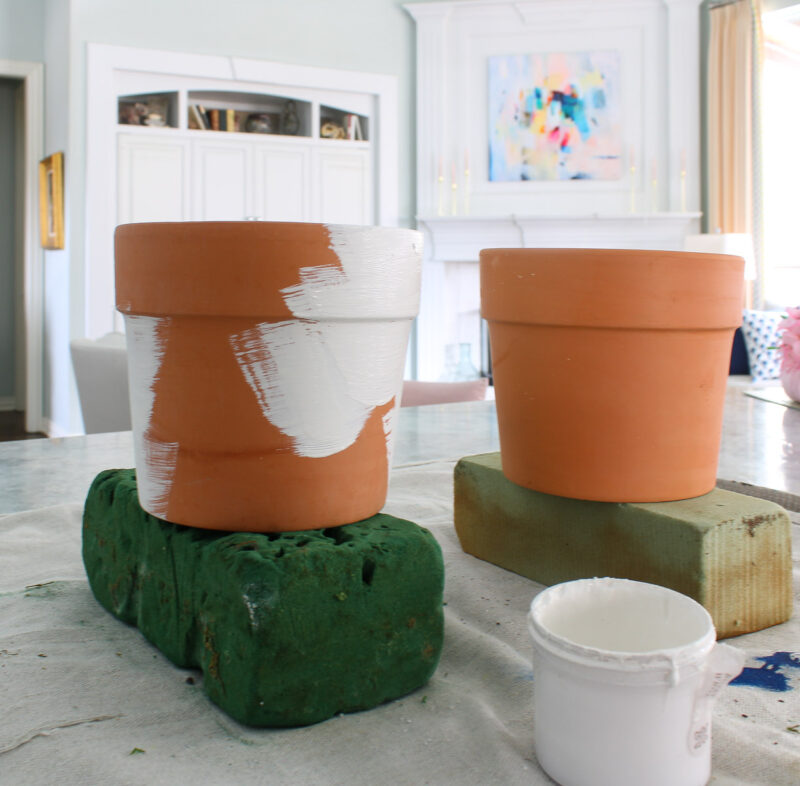
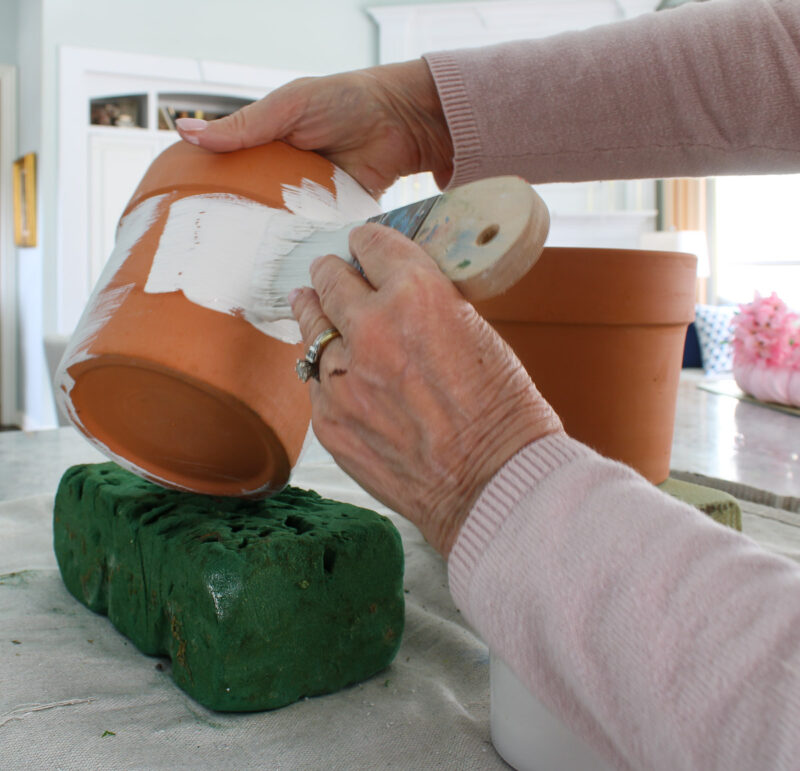
I used One Step Paint in Ballet White, but any acrylic-type paint will work. It only took one coat to cover the orange color of the planters. Let your planter dry completely.
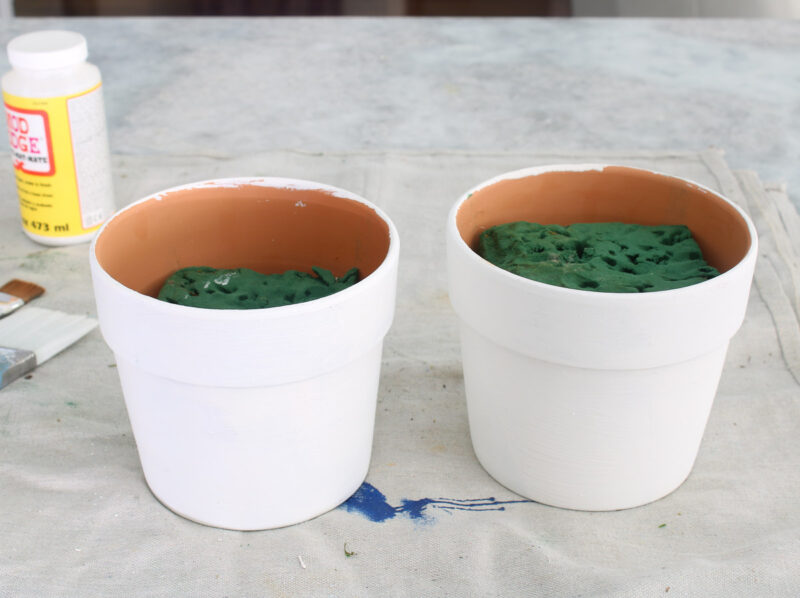
I also went ahead and placed pieces of florist foam into the planters. You want to make sure it’s a firm fit to hold the dowel rod for the topiaries. I ended up adding more styrofoam pieces for a tight fit.
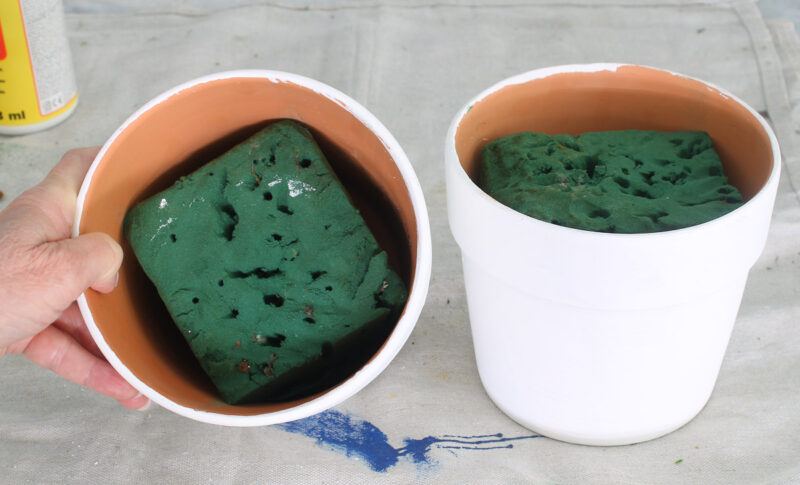
Preparing Your Napkins
Next, open your napkins. There are different ways to prepare your napkins. You can cut or tear the napkin into pieces or use it as one piece.
I wanted to completely cover my planters. I placed the whole napkin on the planter and decided not to cut or tear the napkin into pieces, but to use it as a solid piece. I cut a napkin in half horizontally to preserve the design.
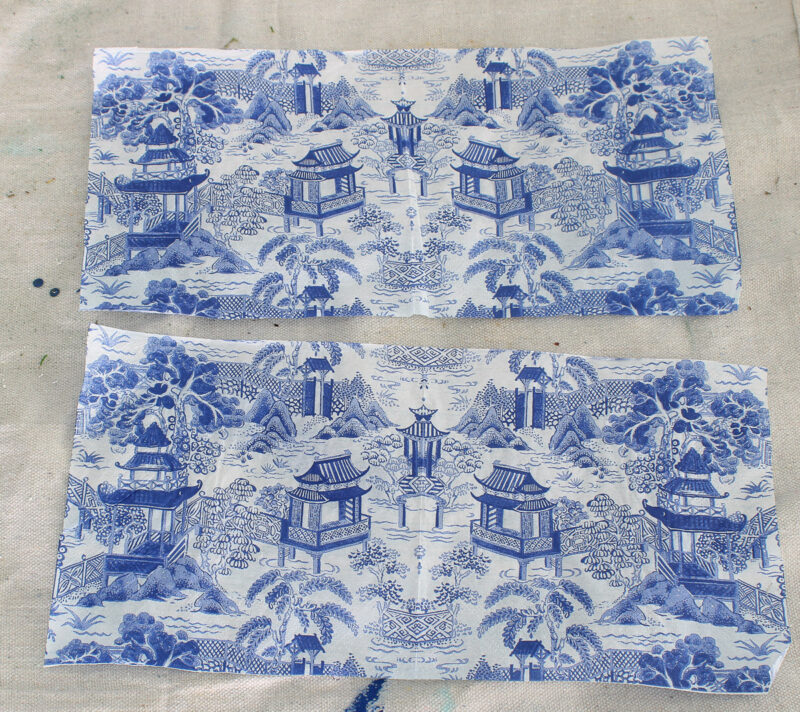
Separate the design layer of the napkin from the bottom layer(s). That’s always the hardest part for me! I rub the corner of the napkin between my fingers. You can use a small, sharp knife point to get between the layers.
By separating the white layers from the printed layer, you ensure the napkin piece adheres smoothly.
Applying the Mod Podge
Step 1 – I poured some Mod Podge into a disposable plastic container.

Step 2 – Then I used the foam brush to apply a thin, even layer of the Mod Podge to the planter in a large area, about 4 inches wide, from top to bottom.
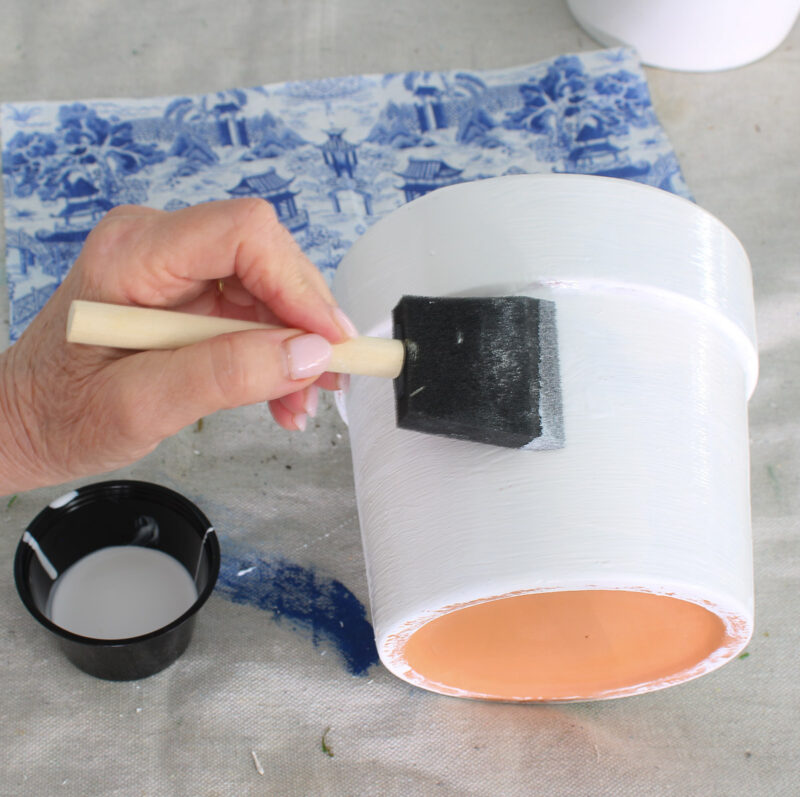
Step 3 – I carefully laid the napkin on the planter with the edge of the napkin at the bottom of the planter.

Since the planter is round, I adjusted the napkin to keep the napkin bottom in line with the bottom of the planter. You will create some folds this way, but it’s the best way to keep the design straight.

TIP: This is something new I tried: Usually, I brush more Mod Podge on top of the napkin. Instead, I used a dry brush to gently go over the napkin. This method worked so much better. It created fewer wrinkles and I didn’t have any tears in the napkin. I worked from the center towards the edges to eliminate any air bubbles.
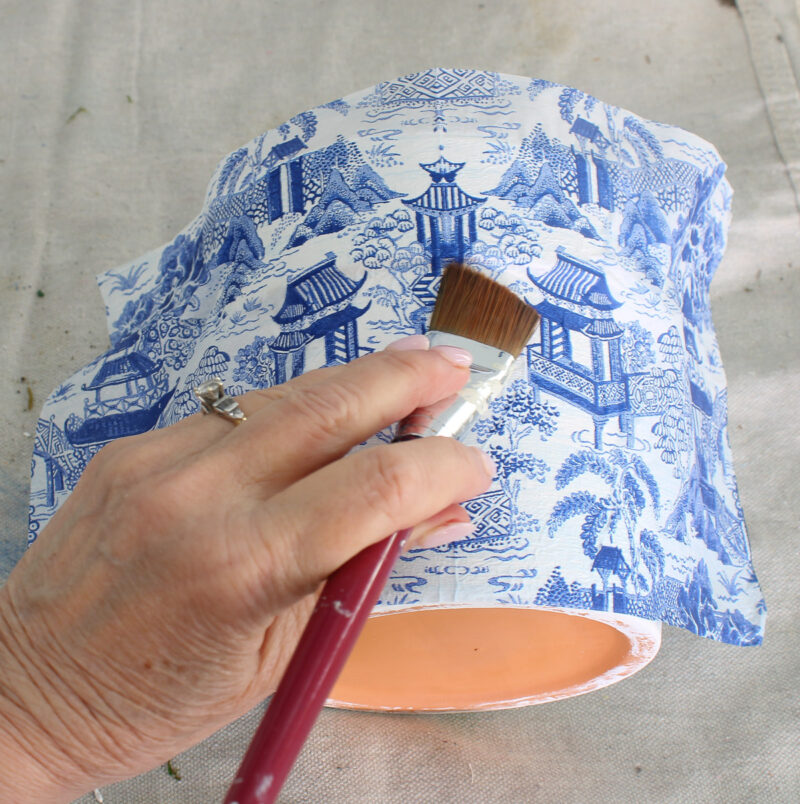
Step 4 – I added more Mod Podge and laid down the remaining napkin as I did for the first section, using the dry brush to smooth out the napkin. I repeated the step on the other end of the napkin.
Step 5 – To cover the remaining planter, I attached the other piece of napkin to the planter, adding more Mod Podge and cutting off the excess napkin with scissors.
TIP – For any areas where there are napkin folds, add a little Mod Podge under the fold and use the dry brush on top to smooth it down.
Step 6 – Apply Mod Podge to the top rim of the planter and brush up on the napkin with the dry brush. Apply more Mod Podge – about 1 inch – on the inside of the planter. Use the dry brush to fold over the napkin and brush down on the inside of the planter.
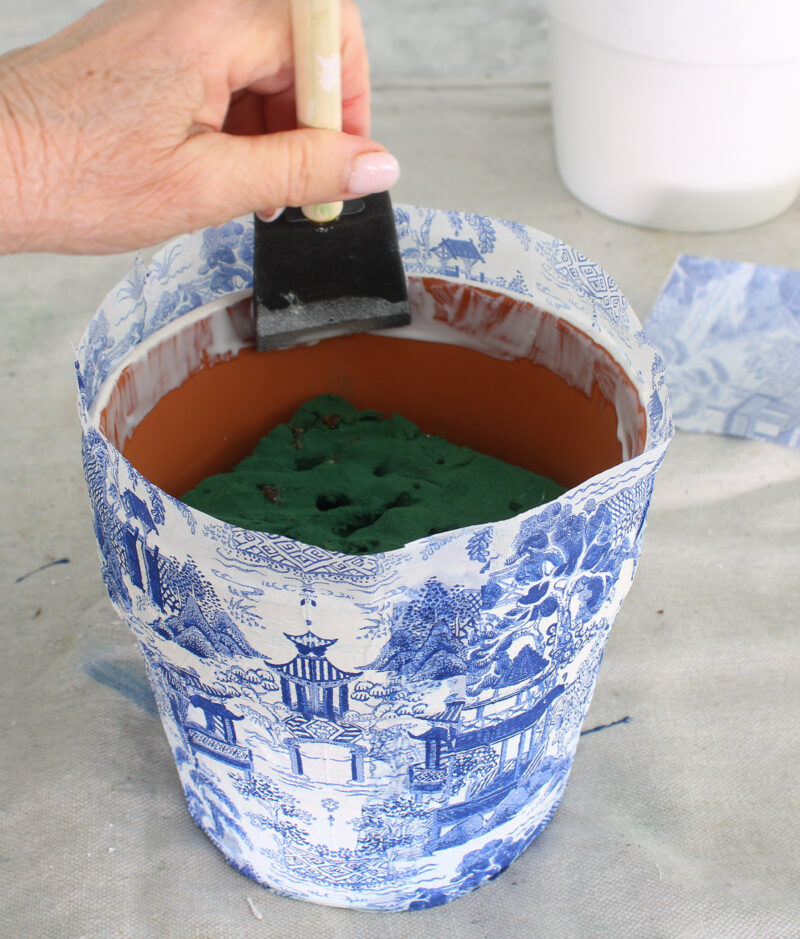
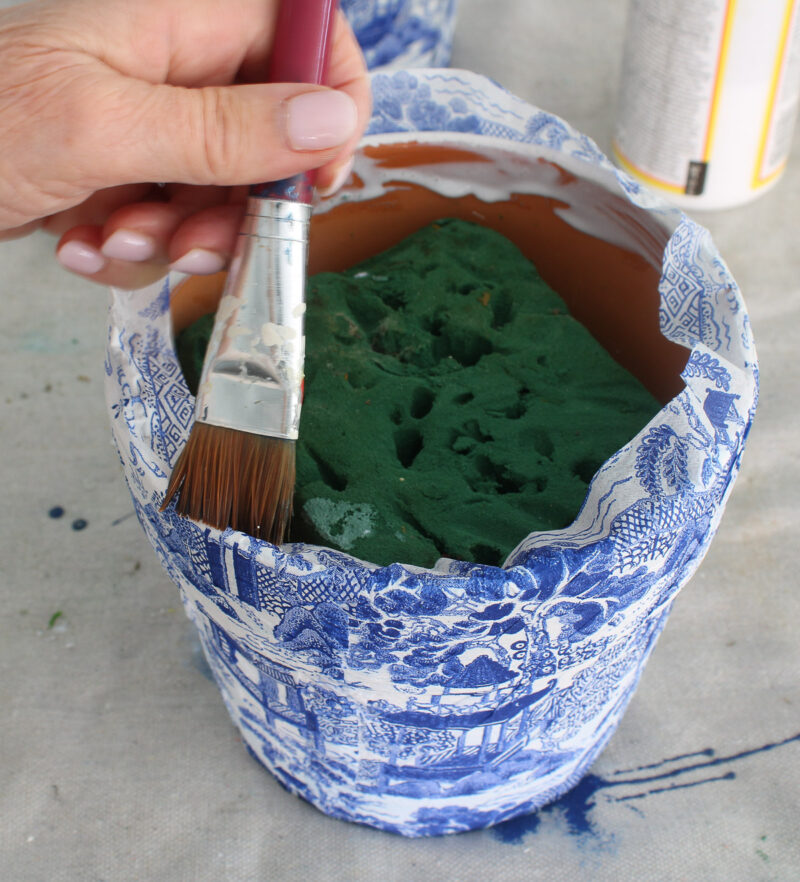
Set the planter aside to dry and repeat the decoupage process with the other planter.
Step 7 – When you have finished both planters, now apply a thin coat of Mod Podge to the planter. This step seals and protects the decoupaged planter. You’ll notice the Mod Podge shows white, but it will turn clear as it dries. Set the planters aside to completely dry.
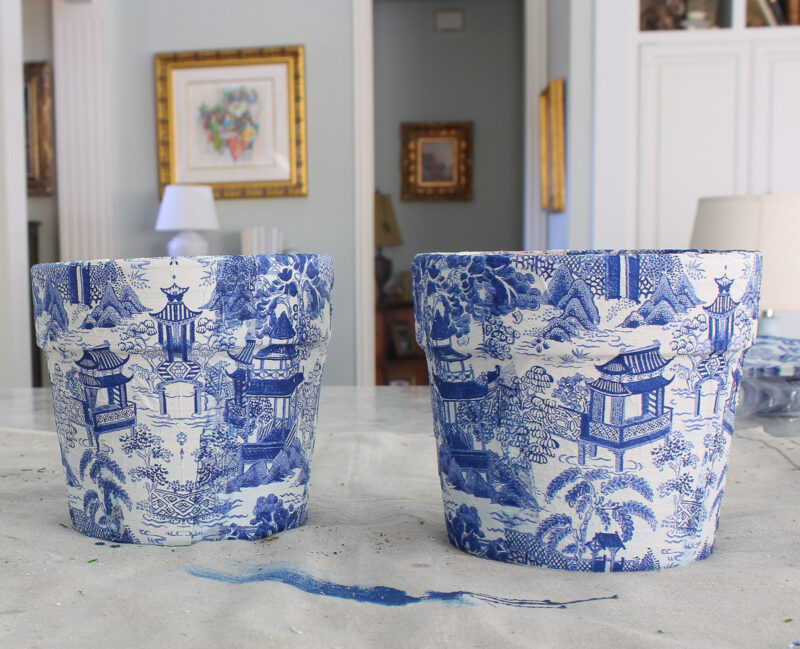
NOTE: When the planters are dry, there won’t be any tackiness and the design will be clear.
Making the Topiaries
While the planters dried, I started on the topiaries. I had never made topiaries from scratch with a styrofoam ball. The topiaries I had purchased were balls of grapevine twigs wrapped in ivy vines.
Drilling a Hole
I used the largest drill bit I had and drilled a hole in the styrofoam balls.
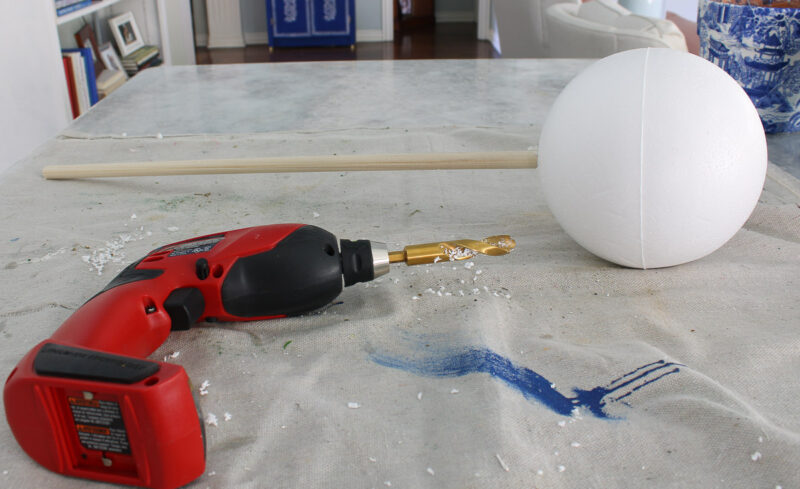
Cutting the Dowel Rods
I placed one end of the leftover dowel rod (It was 24 inches.) in the florist foam. Then I held the styrofoam ball where I thought the right height would be. I thought 15 – 18 inches would be right.
Using my miter board and hand saw, I cut the dowel rods at 18 inches.
I placed the rods back in the florist foam.
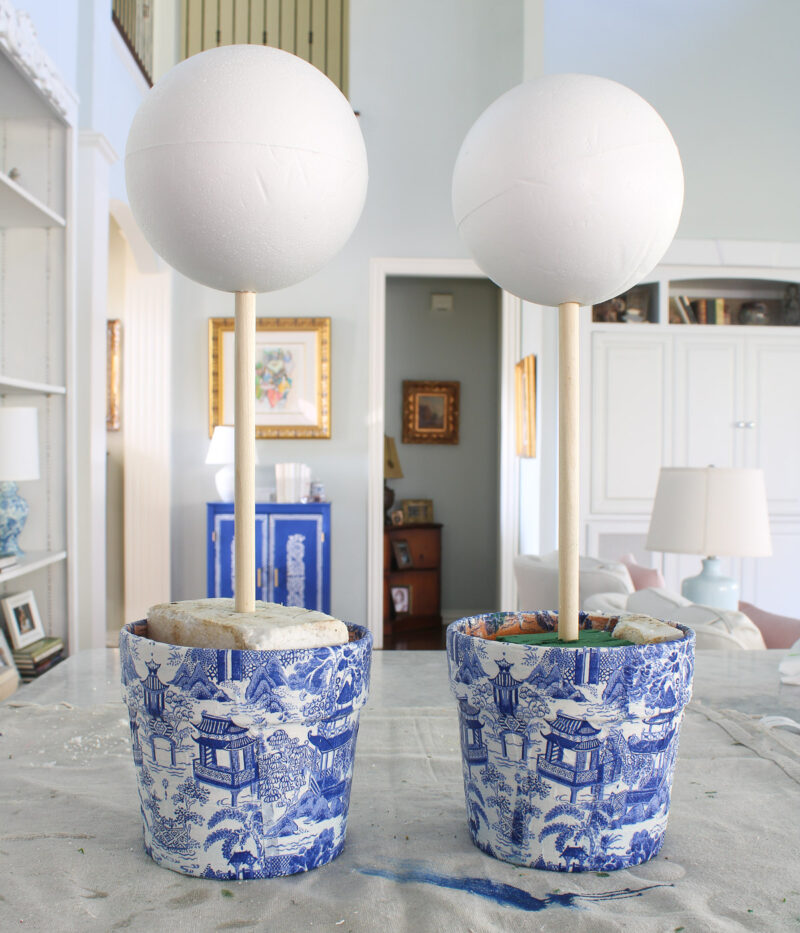
With the topiaries assembled, I could begin to paint them.
Painting the Topiaries and the Dowel Rods
The white of the topiaries had to be covered to not show through. With the dowel rods and styrofoam balls in place, I began painting them.
I used a pretty soft green color called English Boxwood, a One Step Paint. I placed a piece of newspaper around the dowel to protect the Chinoiserie planter.
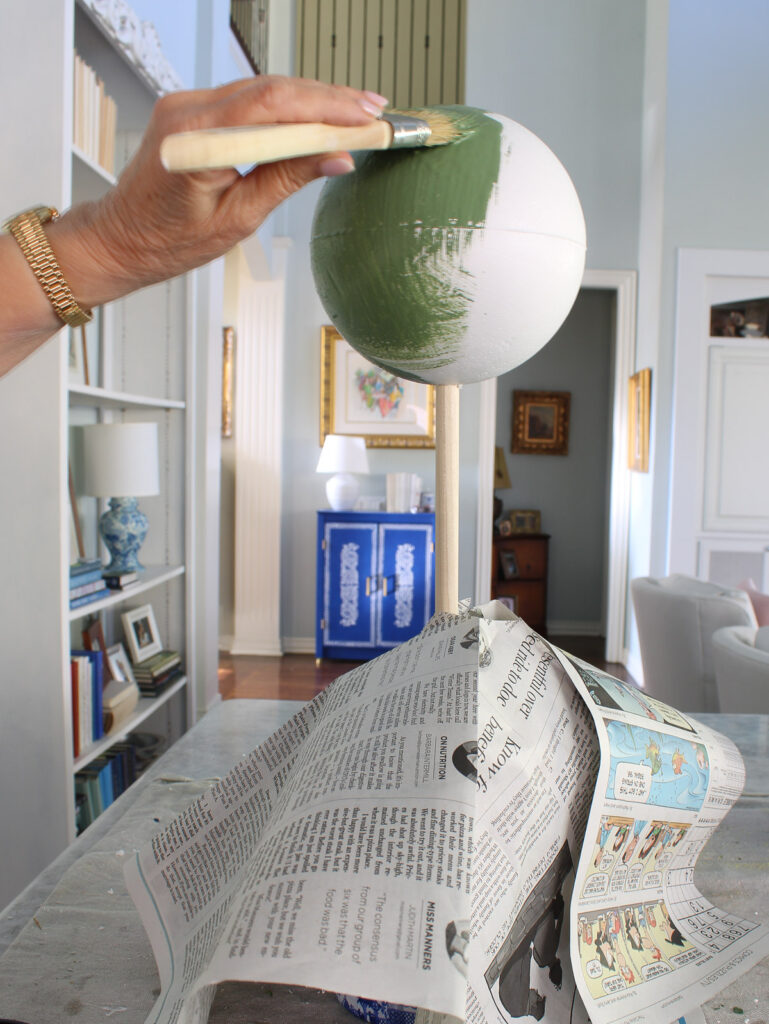
I used foam brushes in two sizes to paint the balls and the dowel rods. It only took one coat to cover.
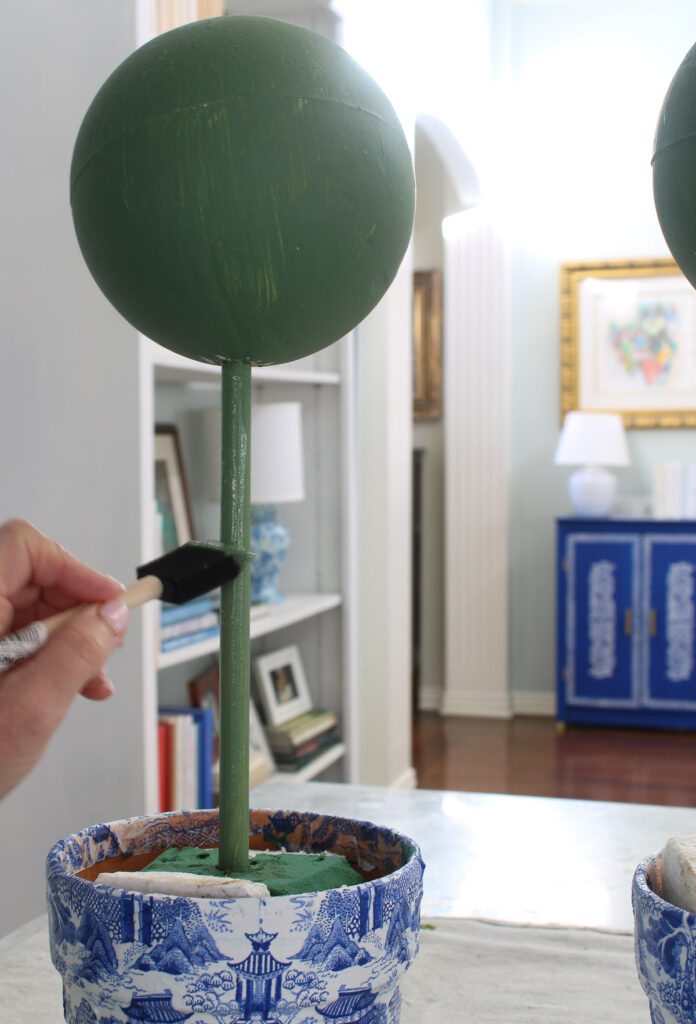

To add more texture to the dowel rods, I wrapped them with green wired twine. First, I disassembled the topiary.
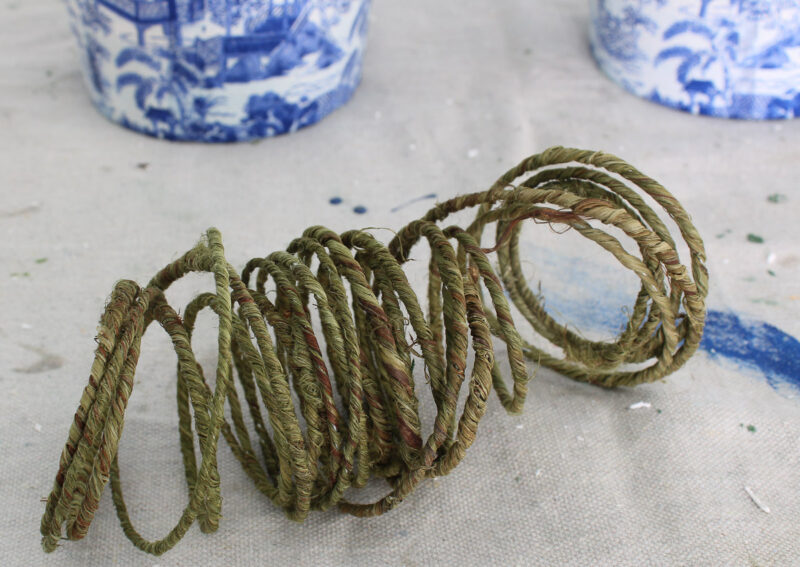
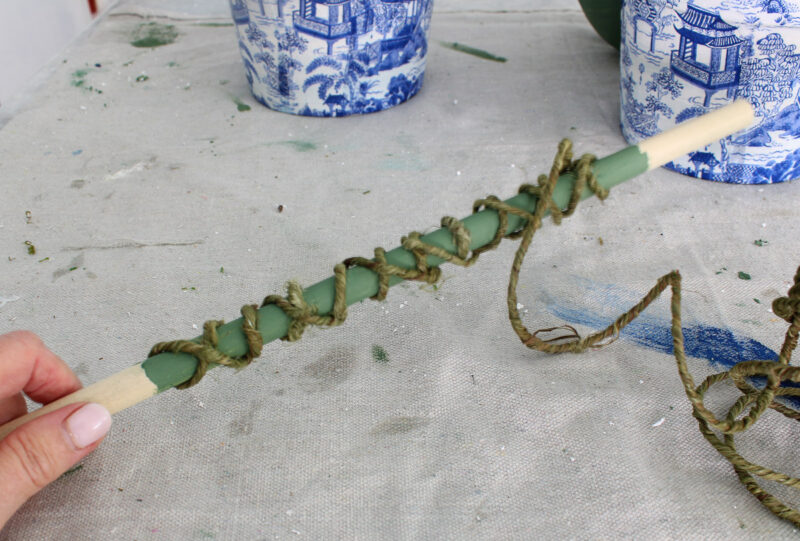
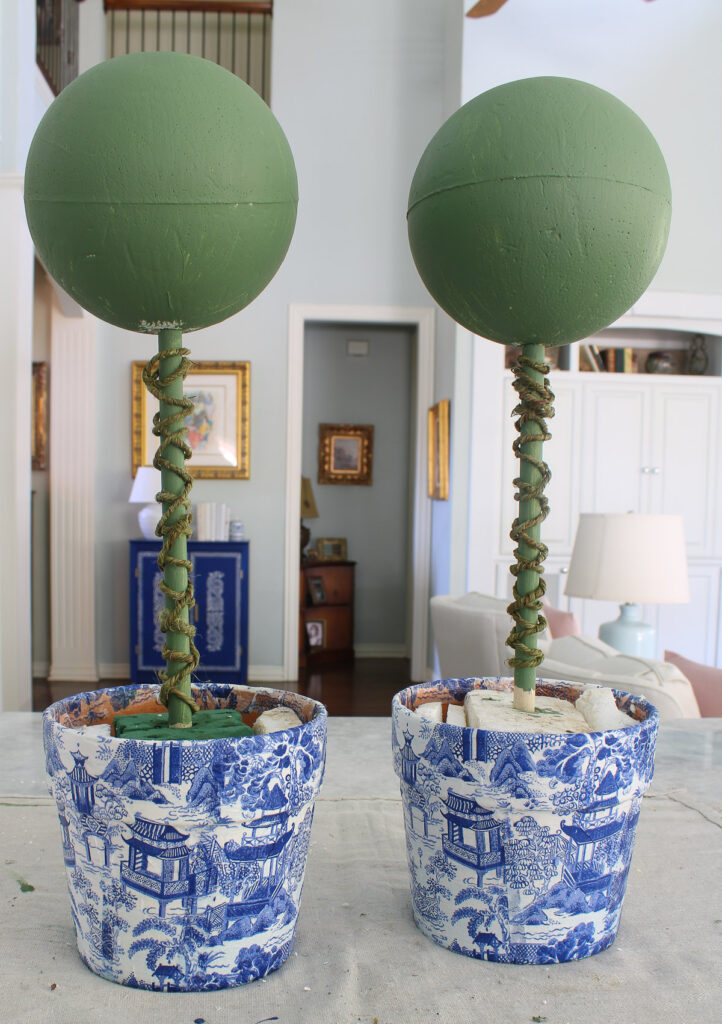
Adding the Greenery to Make the Topiary
I wasn’t sure how to attach the garland to the styrofoam balls. I did heat my Ryobi Glue Gun.
For the first ball, I thought I would add the entire garland at once. I thought gluing the stems would work as I wrapped the garland around the ball.
It became clear that that method didn’t work well. Instead, I started gluing some of the larger leaves to the ball. That approach worked much better, and I was able to cover the ball with the greenery.
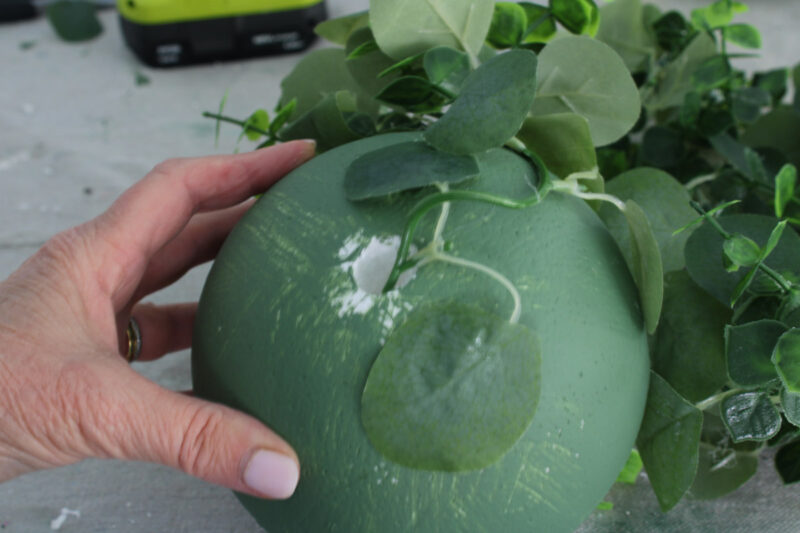
For the second ball, I cut the garland into pieces about 8 – 10 inches long. This method was easier because there was less garland to work with at once.
To fill in sparse areas, I tucked in small pieces of leaves I had saved for this purpose.
I was so intent on wrapping the balls with garland that I didn’t take more pictures. The end result was spot on.
The chinoiserie planter for a handmade topiary came together exactly as I envisioned.
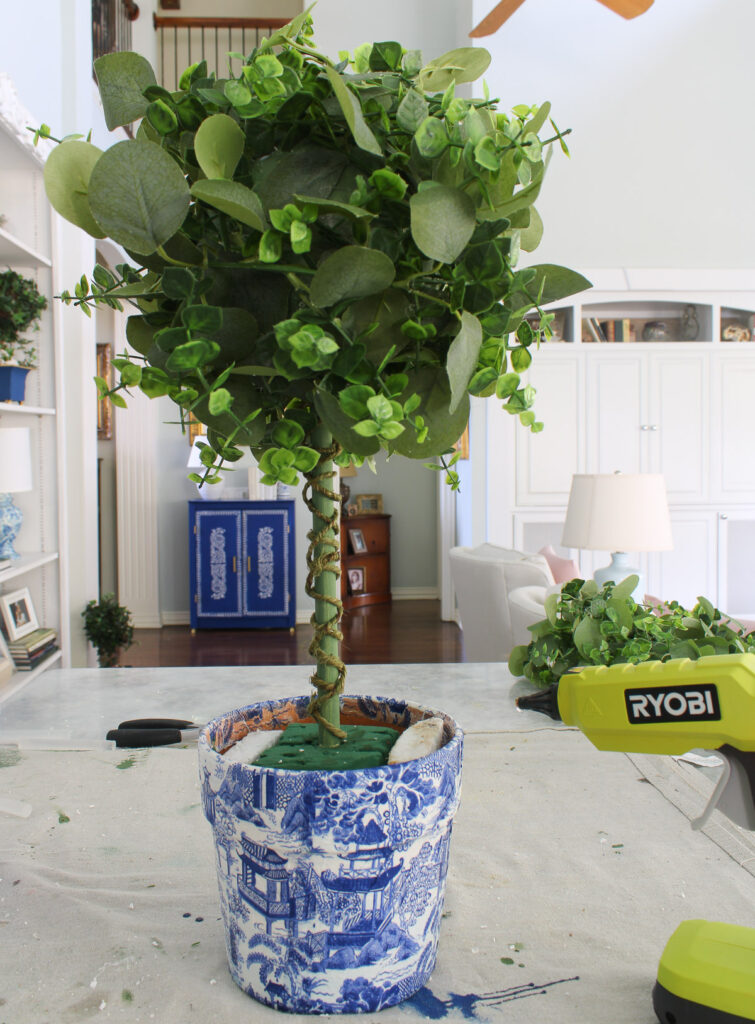
helpful similar projects
Decoupage Projects
Finishing Touches
The final step was to tuck in some crumbled newspaper in the planter.
And, finally, I covered the base of the topiary/Chinoiserie planter with some of my Super Moss. This step is a must-do finishing touch.

My Chinoiserie planters and handmade topiaries were finished and turned out better than I expected. This decoupage project was one of the easiest. Handmade pieces are the ones that give the most satisfaction in decorating our homes.
This chinoiserie planter for a handmade topiary was a fun craft, was fairly simple, and very satisfying to make.
I’m displaying my chinoiserie planters with handmade topiaries in our dining room.
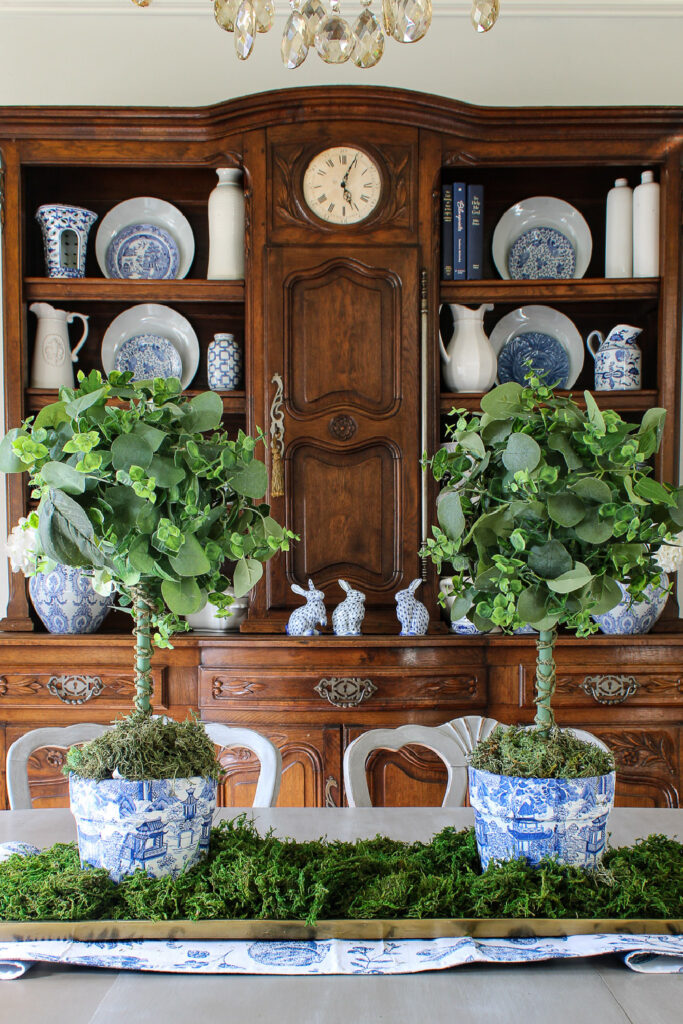
Next up I’ll finish styling the dining room and show it off.

Check out more decoupage projects on my Pinterest Board, Decoupage Ideas.
I hope that you will PIN this chinoiserie and topiary project to your favorite Pinterest Pins.
Please visit my fellow creative crafters, beginning with Sara of Birdz of a Feather.
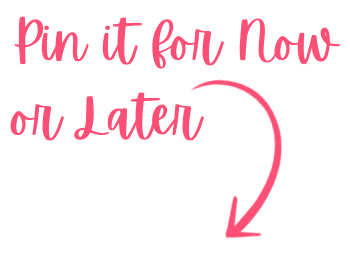
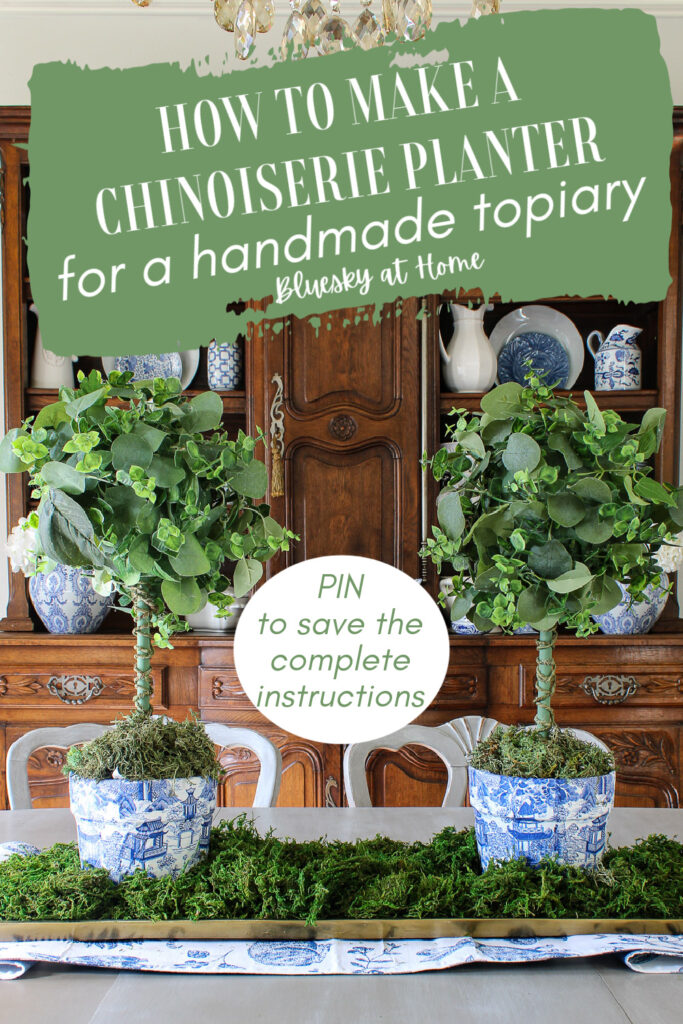


How to Upgrade a Spring Wreath for your Door
Real Easter Egg Wreath
Terracotta Carrot DIY
A Bowl Full of Bunnies
Easy Update For A Cute Pillow With Pom Poms
BHG Inspired Beaded Flowers
3 D Flower Art Canvas
Easter Flateware Holders
How to Make a Chinoiserie Planter for a Handmade Topiary
Design Your Own Fabric
From Thrift Store Frame to Spring Wreath in 15 Minutes

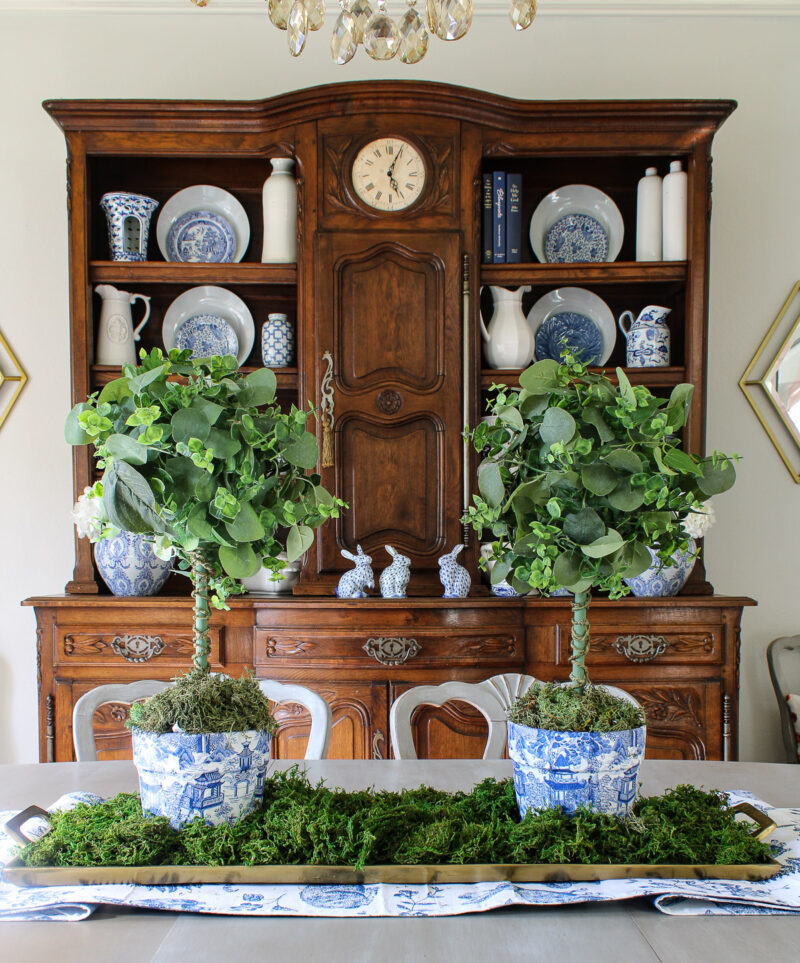

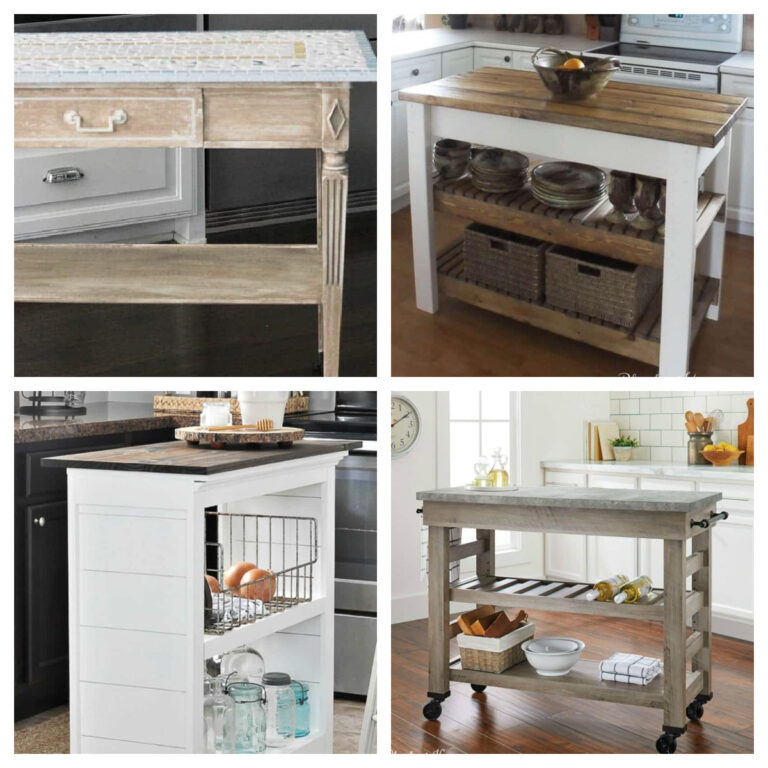

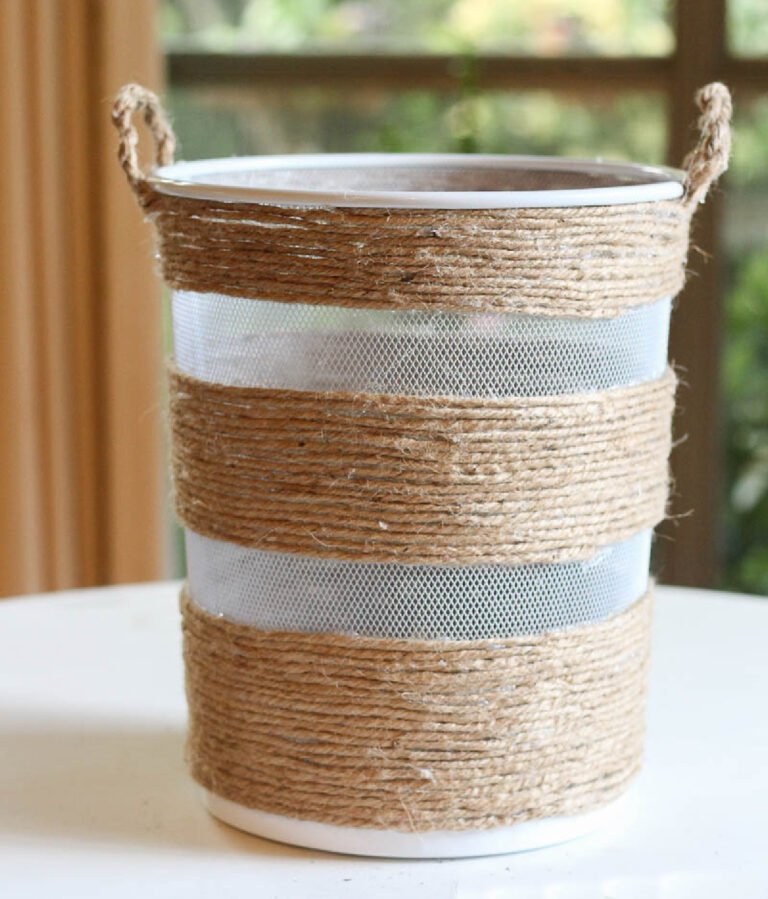




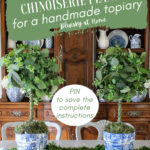
Love the tutorial and such a GORGEOUS result! A lovely addition to any home decor!
Don’t forget to join us over at the Creatively Crafty Linky Party every Wednesday through Sunday
https://creativelybeth.com/creative-crafts-linky-party/
Followed and Pinned!
Creatively, Beth
Thank you so much for the comment, Beth. Linked UP!
Wow! These are so pretty, Carol! I love how you coordinated the topiaries with your china cabinet and accessories! What a lovely idea and project!
Thanks for the feedback, Gail. It was a fun one and very satisfying.
These are beautiful Carol! I love the way you have them displayed too, on a Chinoiserie runner in a moss filled tray~ they look like they are real Chinoiserie, matching your lovely display on the hutch. Thank you for your tips and detailed tutorial, this is a wonderful project!
Thank you, Jenna. Coming from you, I’m thrilled. I’m finishing the dining room table this week and will share the final styling.
Carol, your handmade chinoiserie pots are beautiful and they really elevate your DIY topiary! Blessings, Cecilia @ My Thrift Store Addiction
Thank you Cecilia. I was so pleased with the results. Still working on more styling for the table.
These pots turned out so pretty. You can’t even tell they are made with fabric at first glance at the photos. You did an amazing job on this project. Definitely pinning this one.
Thank you so much, Donna. It was fun project that turned out better than I expected.Thanks for the PIN.
Carol these turned out beautifully! I am definitely going to give this a try. Already added the napkins to my Wish List on Amazon. Great job – and I can’t wait to try it!
Hi Tammy. Thank you for the sweet comment. I loved those napkins when I found them. I’m sure I’ll use the again. The planters turned out better than I expected.
Your topiaries are beautiful, Carol and the greenery you chose is perfect for using them all year long. Great project!
Thank you, Ann. They are definitely a year round accessory!
Your topiary turned out pretty. Love the design and color of them.
I can’t believe you made these from scratch, they look so impressive. Great work, Carol.
Blue and white is so beautiful and classic; I love how easy maintenance this is for a dining room table too!
HI, Sara. and thanks for the feedback. Thank you for hosting the blog hop.